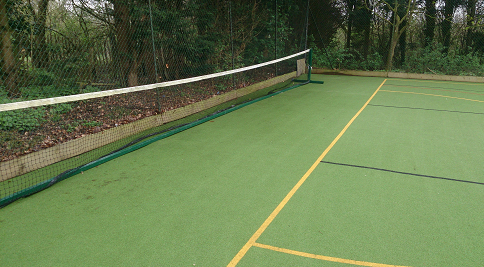With maintenance being such a huge importance when it comes to the lifespan of your synthetic turf product, we thought you might want to know the ins and outs of the maintenance process. So, we sat down with STM Maintenance Manager Ste Smith and Maintenance Co-ordinator Louise Ramage and asked them for their top tips when it comes to maintenance and how you can look after your artificial grass surface.
Ste Smith is a specialist when it comes to looking after synthetic grass. He works with the maintenance machinery to restore surfaces back to their best condition and works predominantly on site. Ste and his team work all year round and he has lots of advice for us.
Louise Ramage is our Maintenance Co-ordinator and main point of contact for clients. She is responsible for booking in and quoting all maintenance projects and providing you with advice for the future.
Steve: Firstly, I would always say that artificial turf surfaces need to be sprayed with moss and weed killers. For larger weeds these can be picked out by hand. Secondly, Signs should always be in place and litter picked up, especially chewing gum as this can get clogged up in the surface and in the heat will penetrate the grass and cause terrible problems with drainage. Finally, I would say that in between maintenance visits the Facilities Managers should try and complete maintenance themselves, whether that be drag brushing or power sweeping.
Steve: The most common mistake is when some surfaces aren’t maintained at all. Occasionally some clients will assume that you don’t need to do anything at all in maintaining a pitch and they think it is best to wait for the professionals to come in. But this is far from true. The more in-house maintenance that is completed, the better and this is also the most cost effective way. One of the most crucial parts of this is not to ignore the weeds!
Steve: It entirely depends on the usage of the surface. For example, some schools may only use their pitch during the day, others hire them out to the community on the evening so it is very difficult to predict this without knowing how often the surface is used. For more advice on this, just call Louise and she will help you.
Steve: A full sized pitch would take 3 to 3.5 hours. For smaller surfaces you might only be looking at 1-2 hours which can be very beneficial for schools as it won’t disturb the school day.
Steve: When it is frosty or snowy weather, we wouldn’t like to complete a maintenance. This is especially applicable to 3G pitches because the rubber crumb infill compacts and freezes together in clumps meaning the machinery doesn’t work as well.
Louise: Sometimes it is really easy to book in a maintenance, for instance I can ring a school and notify them that their maintenance is due and get booked in there and then. In terms of the client, it is super easy for them, they just need to pick up the phone or send over an email.
Louise: You can book up a year in advance
Steve: The power brush de-compacts the infill around the perimeter. There is also a Ferrari machine which is a ride on de-compactor. The leaf blower is pretty self-explanatory and helps to loosen the debris. The knapsack sprayer keeps on top of mould growth and acts as a anti moss and algae treatment.
Steve: All 3G pitches look fantastic once a good maintenance has been completed. Over time the infill is compacted and looks pretty poor. After almost every 3G maintenance out clients comment on how much better the surface feels underfoot and looks. We also completed a primary school maintenance in Berkshire. This school has a maintenance once a year and when the STM team arrived on site the corners were full of leaves which had composted over time. After the maintenance the surface looked like a new pitch!

Louise: Clients always ask how the pile is restore and we do this through a process called drag brushing.
Louise: My contact number is always very beneficial to have which is 01642 713 555
Steve: I always think that clients should take note of repairs and tears in the line. These should be reported immediately. In addition, regular visual checks should take place to look out for weeds, cans, bottles or anything sharp that could cause a severe safety risk. We have come across objects such as prefect badges where the pin is stuck out and as you can imagine this could cause an injury.